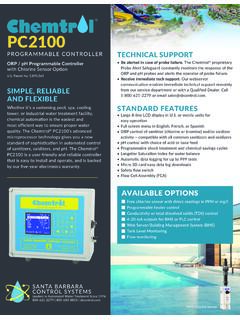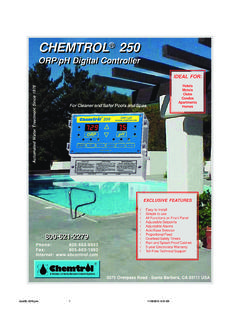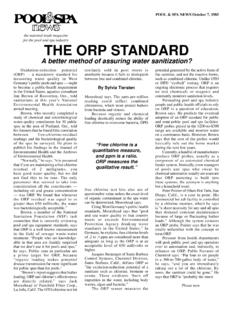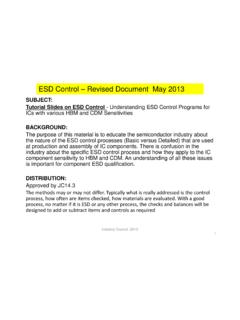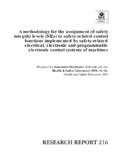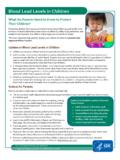Transcription of ORP CONTROL IN POOLS AND SPAS
1 COPYRIGHT SBCS 1998 ORP CONTROL IN POOLS AND SPASBy J. Steininger D. Barbara CONTROL SystemsPrinciple of OperationORP (Oxidation-Reduction Potential) CONTROL ofsanitizers in POOLS and spas has been used all overthe world with great success for over 30 understanding of ORP technology is based onnumerous studies by scientists and health authoritiesin the and other countries. It has been confirmedin the field by thousands of pool and spa operatorswho use ORP controllers every day to monitor theactivity of chlorine, bromine or standards have been recognized by the WorldHealth Organization (WHO), by the Center forDisease CONTROL (CDC) in Atlanta, Georgia, by stateand local health departments and by the NationalSpa and Pool Association (NSPI) in Washington,DC. ORP CONTROL is required by code in several statesand more states (such as California and Florida) areplanning to add it to their new and PPM Test KitsPool and spa operators must realize that test kit measurements differ fundamentally from ORP readings.
2 The relationship betweenORP and PPM readings is quite complex, as show in Figure 1, a computer-generated three-dimensional representation of ORP vsPPM and pH and DPD test kits have been traditionally used for monitoring sanitizers. They differ from ORP readings because they aredesigned to estimate the concentration of sanitizer in water (PPM of chlorine or bromine).On the other hand, ORP measures the chemical activity of thesanitizer, more specifically its oxidizing power . For water treatmentapplications, ORP is the most relevant measurement since sanitizersare used for their biological activity, their ability to kill germs andbacteria, which has been shown in many studies to be related totheir oxidizing KitsPool and spa operators must realize that test kit readings aresubject to significant errors resulting both from variations inreagent properties and user 2 shows the results of laboratory testing of chlorinated waterwith two well-known DPD test kits for free chlorine and with acolorimeter calibrated by amperometry.
3 It can be seen that thereare wide differences - more than 50% - between baseline colorimeterand test kits readings. For 1 ppm of free chlorine, the DPD test kitsshow values of and respectively. For 2 ppm, the test kitreadings range from to 1 - Variations of ORP with PPM and pHFigure 2 - Comparison of DPD Test 500550600650700750800850900 ORP Test KitsppmColorimeterColorimeterAQUALITYAQU ALITYTAYLORTAYLORTAYLORTAYLORTAYLORTAYLO RB aseline Colorimeter, ppmBaseline Colorimeter, ppmIn addition, errors are also caused by individual users due to the differences in color perception. Statistical analysis of test kitreadings by 10 different individuals showed differences as high as 50% to 100% of the readings. For consistent results therefore,tests kits should be read by the same results confirm that the DPD test kits are qualitative, or at best semi-quantitative. In other words, they can indicate thepresence or absence of free chlorine, and the approximate concentration levels but not with the degree of accuracy that is frequent problem with test kits is caused by bleaching of the reagents at high chlorine levels.
4 The operator is led tobelieve that there is no chlorine or that the pH is very low when in fact there is too much chlorine. If this happen, the ORP reading willbe / PPM ConversionIn clean and relatively clean water, the ORP andtest kits methods are complementary because theactivity of a sanitizer depends primarily on itsconcentration. In other words ORP and PPM canbe correlated. The curves representing thevariations of ORP as a function of PPM and pHwere first determined by Uniloc in the 70 s. Theyhave been used for many years in older analogtype controllers for graphical determination of PPMvalues from ORP readings. Figure 3 shows arecent redetermination under controlled conditionsin the CHEMTROLTM chemistry laboratory. Moderncontrollers with microprocessors use differentalgorithms to represent these shown in Figure 3, the most important factoraffecting sanitizer activity is pH, because it changesthe concentration of the active form of free chlorine,hypochlorous acid, HOCl.
5 As a result, chlorine andbromine become less effective at higher pH. Thisis why it is essential to maintain a stable pH value of to concentration and pH, there are other significant factors which can greatly influence the activity of a sanitizer. Althoughdifficult to define, they are known to include many of the organic and inorganic contaminants that are found in POOLS and can be confusing to pool and spa operators because each test kit reacts differently to these contaminants. In contaminatedwater, it s very difficult to obtain reliable readings from any test kit. At best, they can be used to detect the presence orabsence of stabilized POOLS , the HOCl concentration and therefore the ORP readings can vary daily as a result of exposure to the UV raysin the sun. Due to the slow rate of chlorine release from the cyanurate compound, the HOCl concentration decreases during the dayand increases after sunset, even though no chlorine is added. This does not show on test problem arises with organic bromine (dihalo or bromine sticks), known by its chemical name as 1-bromo-3-chloro-5,5-Dimethylhydantoin.
6 Besides bromine and chlorine, the formula shows an organic part that remains in the water and accumulatesprogressively. The accumulation of organic material reduces the effectiveness of the sanitizer. This is why it is strongly recommendedto use bromine only in conjunction with ozone in order to oxidize and eliminate these organic systematic study of chemical and biological conditions in commercial spas by the Oregon Health Department has proved conclusivelythat ORP testing provides the most reliable index of sanitary conditions in heavily used POOLS and spas, regardless of sanitizerconcentration, pH level and and spa operators must therefore learn to trust ORP readings. If there is a disagreement between ORP-derived PPM valuesand test kit readings, it s usually due to the effects of 2 3 5 7 10 PPMFREE CHLORINEFREE CHLORINEFREE CHLORINECHEMTROL(TM) 1996 TEMP = 25 CALKALINITY = 100 PPMTDS = 500 PPMFREE CHLORINEFREE CHLORINECHEMTROL(TM) 1996 TEMP = 25 CALKALINITY = 100 PPMTDS = 500 PPMCHEMTROL(TM) 1996 TEMP = 25 CALKALINITY = 100 PPMTDS = 500 PPMCHEMTROL(TM) 1996 TEMP = 25 CALKALINITY = 100 PPMTDS = 500 PPMF igure 3 - PPM Readings vs.
7 ORP and pHPage 2 Page 3 Using ORP controlThe recommended ORP level for POOLS and spas is between650 and 750 mV. It can be even higher in very clean absolute minimum of 650 mV applies to both chlorine andbromine. In contaminated water however, the controller will callfor larger concentrations of chlorine or bromine to maintain theORP level. The more contaminated the water is, the moresanitizer is required to generate the required ORP is fundamental to the understanding of water are no commercially available calibration solutions for ORPin the range of 650 to 750 mV that is recommended for watertreatment. However, Figure 4 shows that CHEMTROLTM sensorsgive consistent readings. In this test, 10 sensors showed readingswithin + or - 2 mV after reaching full ORP sensors can t be calibrated, ORP CONTROL must be based on the selection of a proper ORP level corresponding to therecommended chlorine or bromine levels in clean water. This level may vary for different no case, should the ORP setpoint be below 650 mV.
8 After the proper ORP setpoint has been selected, it should not be changedto accommodate varying sanitizer readings, except for calibrationThe theoretical relatioonship between PPM and ORP can be derived from the chemical equilibrium equations for free (1) below shows that PPM varies exponentially with / Reducer = exp[ORP * nF / RT](1)This is in general agreement with the experimental data from the Uniloc and CHEMTROLTM studies, which are shown in Figure 5 fora constant pH value of of the exponential relationship between PPMand ORP, small changes in ORP readings resultin large variations in PPM values at free chlorineconcentrations above 2ppm. In other words, a changeof ppm is significant at ppm but much less soat ppm. The same goes for the water becomes loaded with contaminants, theORP controller calls for increasing PPM values tooffset the decreasing effectiveness of chlorine. If thePPM readings exceed the values allowed by the healthdepartment, the water should be replaced or thecontaminants destroyed with a strong oxidizer.
9 Thisis particularly important with bromine or with cyanuricacid-stabilized summary, PPM readings are more accurate at lowsanitizer levels and in cleaner 4 - Reproducibility of ORP SensorsFigure 5 - Variation of PPM with ORP500600700800024681012 FREE CHLORINEORPUNILOC 1970pH = (TM) 1996pH = = 25 CALKALINITY = 100 PPMTDS = 500 PPMORP OF FREE CHLORINE AT pH = OF FREE CHLORINE AT pH = OF FREE CHLORINE AT pH = OF FREE CHLORINE AT pH = OF FREE CHLORINE AT pH = mVTIME IN CHLORINATED WATERMean = 867 mVSD = 5 mVMean = 867 mVSD = 5 mVMean = 867 mVSD = 5 mVMean = 867 mVSD = 5 mVMean = 867 mVSD = 5 mVMean = 867 mVSD = 5 mVMean = 867 mVSD = 5 mVMean = 876 mVSD = 4 mVMean = 876 mVSD = 4 mVMean = 876 mVSD = 4 mVMean = 876 mVSD = 4 mVMean = 876 mVSD = 4 mVMean = 876 mVSD = 4 mVMean = 876 mVSD = 2 mV5 min5 min5 min5 min5 min5 min20 min20 min20 min5 min20 min5 min5 min5 min5 min20 min5 min5 min5 min5 min5 min5 min5 min5 min5 min5 min5 min5 min20 min20 min16 hrPage 4 ORP Controller ProcedureThe recommended procedure for operation of an ORP controller is as Start with clean water, preferably early in the day before use by Adjust the pH to to Adjust the chlorine level to 1 to 2 ppm (2 to 4 ppm for bromine).
10 4. Let the recirculation pump run for several Read the ORP value and use it as set Verify readings after 1 Keep calibration changes to a minimum, preferably by the same operator and at the same time of the Adjust the chemical feeders if they are constantly overfeeding or calibrationThe controller should automatically display the PPM values corresponding to the ORP and pH readings in clean the displayed PPM value differs slightly from test kit readings, it can be re-calibrated using the programmed calibration variations in PPM readings should be seen as evidence that the water is contaminated and should be replaced or shockedwith an Testing - The Acid TestA simple test can be used to verify that the ORP sensor is operating properly. It is called The Acid add a little bit of acid in the intake of the recirculation line and watch the ORP readings. Because of the increased activity of thesanitizer at low pH, the ORP reading should increase dramatically.
